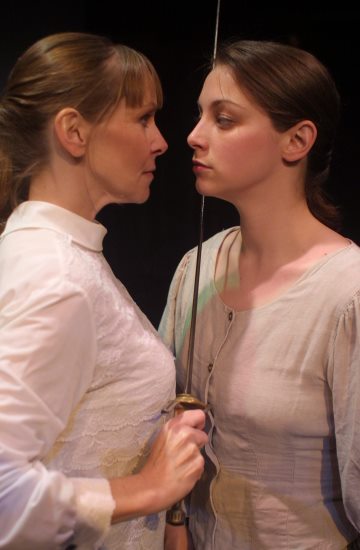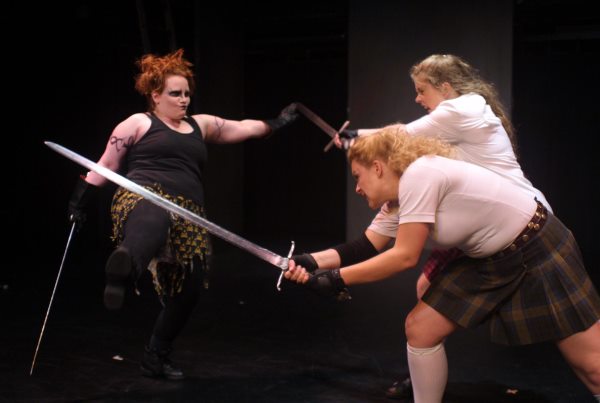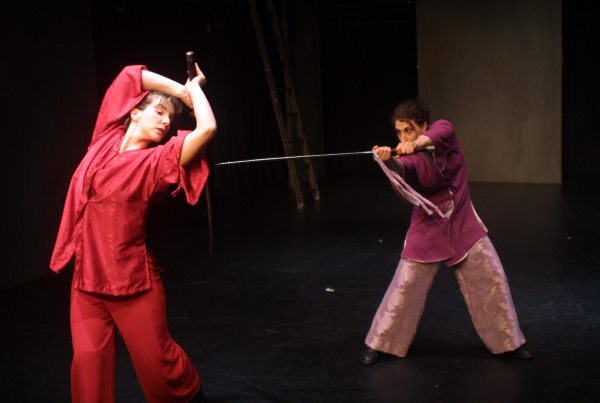Journal of Theatrical
Combatives Nov 2006
Stage Combat at the 2006 Association for Theatre in Higher
Education Conference
copyright © 2006 Deborah Klens-Bigman, all rights reserved
I have been to the Association for Theater in Higher Education
conference numerous times over the years, as a grad student, an
adjunct, and lately and less frequently as an independent
scholar. My interest in the group could be said to have waned
with time, as the politics and pressure of academe have come to no
longer apply so directly.
However, this year's conference, held August 3 - 6, 2006 at the
Chicago Palmer House hotel, was somewhat different, owing to the
several sessions that dealt with issues surrounding fight choreography
and stage combat. As the editor of the Journal of Theatrical
Combatives, I am always on the lookout for new material and perhaps
people who will also contribute their share. The stage combat was
also a nice antidote to the sessions of droning and ramblings of people
simply reading papers, however interesting the content.
The first session I attended was "Stage Violence for Playwrights
and Dramaturgs: What Writers Need to Know About Fighters," organized by
Meron Langsner, a stage combat choreographer/doctoral student from
Tufts University in Massachusetts. Langsner's presentation
discussed issues of logic and verisimilitude in fight scenes.
Owing to the increasing popularity of fight scenes on stage and screen,
aspiring playwrights would often like to include an action scene but
don't always situate the scene properly according to the plot or
characters. Though it may seem obvious to some of us, a conflict
that becomes physical cannot just come out of thin air. The
playwright needs to sow the seeds of a potential physical conflict much
earlier than when the conflict actually arises. Langsner used
successful and unsuccessful examples of fight scenes in scripts to
illustrate his point. He also discussed practical matters, such
as giving the choreographer enough time to train actors involved in
fight scenes. Directors should also make sure the choreographer
or playwright is not inflicting her/his inner Errol Flynn on
undertrained or unskilled actors. Put simply, the fight scene
must be introduced by some dialogue or action some time before the
fight erupts, must fit with the characters and plot, must be
well-prepared, and must have a resolution of some kind in order to make
sense to the audience (we are talking realism here).
Though the turnout for Langsner's session was unfortunately small
(ATHE for some reason decided to accept every proposed session this
time around, seemingly at odds with the idea that theatre people might
want to spend time Friday night at the theatre), I learned a bit
about how professionals approach the various problems of writing and
staging fight scenes.
Saturday afternoon I attended the "Babes with Blades" session
presented by the troupe of the same name. The Babes are a women's
stage combat group that has been active in the Chicago area for several
years. The group laid out their raison d'etre and then gave a
short presentation of vignettes of several types of fight scenes
rapier and dagger, unarmed fighting and broadswords.
I enjoyed the fight scenes, but had trouble placing them in any
sort of context. Somehow violence between men needs much less
background than fights between women. Fairly or unfairly, we
accept men fighting without much explanation. However, we are so
unused to seeing female-female violence that without a clear
justification, the Babes' fight scenes ended up being a little
disconcerting to watch, even for me.
The fight scene vignettes also underscored another serious problem
for the group - lack of good dramatic material to perform. To
remedy the situation, BwB has sponsored a playwriting context, which
netted more than 30 scripts, one of which was performed this
season.
Part of the BwB stated rationale is to empower women and girls to
stand up for themselves. While I laud the idea, the martial
artist in me thinks they should not over-psychologize their work and
should instead concentrate on being one of the area's best stage combat
troupes (lead by example, I say). For example, the Lady
Cavaliers, an NYC-based troupe, focuses on the little-known tradition
of women in combat, a more concrete and accessible goal. Feeling
the same dearth of material, the Lady Cavaliers has also commissioned
plays to perform. LC has also included men in their casts when
need arises, rather than concentrating on activities exclusively
involving women, which broadens their audience appeal.
Nevertheless, Babes with Blades is an appealing and exciting
group, and the increasing visibility of women stage combat performers
in media bodes well for their future.
The last session I attended truly got the audience off its butt:
"Swordplay: Safe and Simple," a workshop in basic stage combat with
rapier, taught by Dr. Andrew Hayes, a SAFD (Society of Stage Fight
Directors) Certified Teacher, from DePauw University. Hayes took
us through a simple rapier sequence, emphasizing proper form and safety
in execution, and it was a good deal of fun. I have not done any
rapier work/stage combat work in many years, since I was a fencer
charged with choreographing a community theatre production many years
ago (I took stage combat rapier lessons to prepare).
Of course, as a martial artist, I kept feeling the disconnect: the
movements were too big to be effective in the way I would have defined
them. I was very impressed that both Langsner and Hayes had
experience in martial arts, and yet could visualize and realize all
this fake stuff in purely dramatic terms. Perhaps it was easier
that their experience was generally in unarmed martial arts vs. armed
stage combat. However, it is not that easy. One of the
workshop participants, who sometimes choreographed fight scenes at her
university, told of how she once had a problem with a karate student
who took the stage conflict he was involved in way too seriously (he
was replaced). Even though I was well aware of the difference, I
had a difficult time not sending my rapier to more efficient targets
than the phrase d'armes intended.
The presence of stage combat at ATHE was very welcome. After
a raft of papers year after year that, whatever the topic, emphasize
book learning or deal with movement in tangential ways, presenting work
on the "action" part of theatre was a happy development. Though I
prefer martial arts to stage combat as an activity, the emphasis on
proper form and excellence in training and execution was something we
all have in common, and something we all shared in Chicago this
year.

Photos courtesy of Babes with
Blades. Photographs by Johnny Knight.
Our
Sponsor, SDKsupplies



